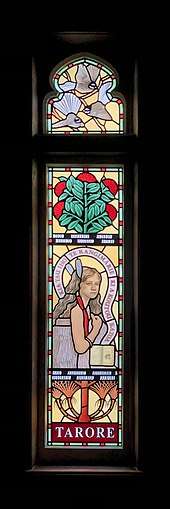Tārore
Tārore (?1824–1836) was the daughter of Wiremu Ngākuku, a rangatira (chief) of the Māori iwi (tribe) Ngāti Hauā in the North Island of New Zealand. She was considered a child prodigy, a Christian martyr and her story is treasured by the New Zealand church.

Ministry
Tārore was taught to read from the te reo Māori (Māori language) Gospel of Luke, from the Bible, by Charlotte Brown of the Church Missionary Society (CMS) from the age of ten. She was considered a prodigy because of her ability to memorise much of the book. She would recite portions of the Gospel to crowds of 200–300 of her people and was supported by her father as a lay evangelist.[1][2]
Murder
In October 1836, Tārore was evacuated with the other pupils from her CMS school in Matamata, because of a violent and cannibalistic conflict between iwi. She took her father's rare te reo Māori Gospel of Luke in a small kete (basket) she wore around her neck. Whilst stopped for the night of 18 October near the Wairere Falls in the Kaimai Ranges, her party of 24, including her peace-loving father, was attacked by a Ngāti Whakaue war party from Rotorua, Tārore was murdered and the book stolen by warrior Paora Te Uita. Her ritualistically mutilated body was carried back to the Matamata mission station and was given a Christian burial. The Māori law of utu required revenge for her death, but at her tangi (funeral) her Christian father spoke words of forgiveness and said "do not rise up to obtain satisfaction for her. God will do that."[3][4][5][6][7]
Aftermath
Several weeks later, back in Rotorua, Uita asked visiting ex-slave, mission school educated Ripahau (aka Matahau) of Ngāti Raukawa to explain the book to him. This led him to become a Christian and to ask for forgiveness from Ngākuku, leading to their reconciliation. The book, identified by Ngakuku's inscribed name, was then taken south and ended up in the hands of Ripahau again in Ōtaki. It continued to play a key role in Māori evangelising to Māori for years to come, including the introduction of the Gospel to the South Island for the first time.[3][4][5][6][7][8]
Legacy
Tārore's grave was located in 1976 at the Matamata pā (fortification) site near the village of Waharoa, and the following year a white cross headstone and plaque were created to commemorate her death, her father's forgiveness and the spread of Christianity through New Zealand that was influenced by her book.[4][6]
In 1997, The Legend of Tarore documentary was broadcast on New Zealand national television.[9][10]
In 2009, the Churches Education Commission gave 240,000 free copies of Joy Cowley and Mary Clover Bibby's book Tārore and her Book to New Zealand primary schools because of its historical significance to both Māori and Christianity in Aotearoa New Zealand.[11][10]
Tārore's story has been described as "the iconic narrative of the early missionary period" in New Zealand.[10] While the Archbishop of Canterbury's Representative to the Holy See, Sir David Moxon described Tārore's story and Gospel book as "amongst the taonga (treasures) of the Church in Aotearoa".[8]
References
- "The Treaty and the Bible in Aotearoa New Zealand". Anglican Church in Aotearoa, New Zealand and Polynesia. Retrieved 6 June 2020.
- "Following Jesus Christ today". Anglican Taonga. Retrieved 6 June 2020.
- Newman, Keith (2010) [2010]. Bible & Treaty, Missionaries among the Māori – a new perspective. Penguin. p. 101-103. ISBN 978-0143204084.
- Ruka, Jay (2017) [2017]. Huia Come Home. Oati. p. 38-40. ISBN 9781877487996.
- Morrison, Hugh; Martin, Mary Clare, eds. (2017) [2017]. Creating Religious Childhoods in Anglo-World and British Colonial Contexts, 1800-1950. Routledge. p. 2-3. ISBN 978-1-4724-8948-7.
- Macdonald, Charlotte; Penfold, Merimeri; Williams, Bridget, eds. (1991) [1991]. The Book of New Zealand Women, Ko Kui Ma Te Kaupapa. Bridget Williams Books Ltd. p. 653-654. ISBN 0 908912 04 8.
- "Tarore's Legacy". Te Ara, The Encyclopedia of New Zealand. Retrieved 27 July 2019.
- "Tarore and the Spread of the Gospel". New Zealand Church Missionary Society. Retrieved 27 July 2019.
- "Epitaph – The Love Letter/The Legend of Tarore". Ngā Taonga. Retrieved 27 July 2019.
- Troughton, Geoffrey; Lange, Stuart, eds. (2016) [2016]. Sacred Histories in Secular New Zealand. Victoria University Press. p. 40. ISBN 978-1-77656-095-0.
- "Tarore's tale helps kids read". Stuff. Retrieved 27 July 2019.